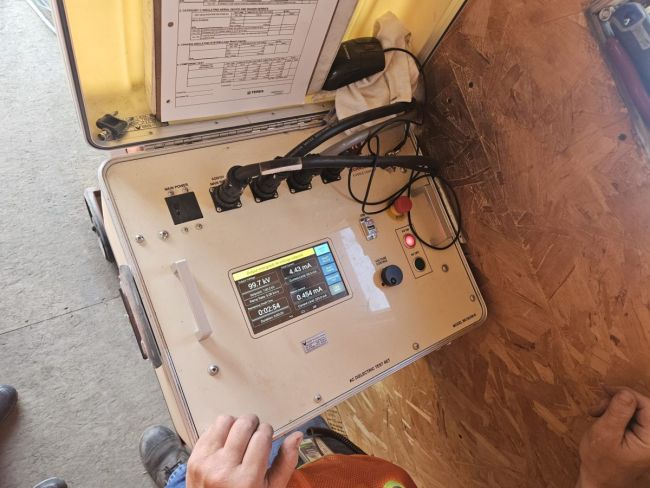
Dielectric Testing for Insulating Aerial Devices
Knowing when to perform these tests – and who is responsible for them – is essential to worker safety.
Insulating aerial devices and digger derricks are used to provide a level of protection to their operators and ground personnel who work around energized power lines. Following established safe work procedures is critical, as is testing and maintaining the equipment so that it continues to provide the insulation users expect. You cannot simply look at a unit to determine if it will provide the insulation expected; it must be tested.
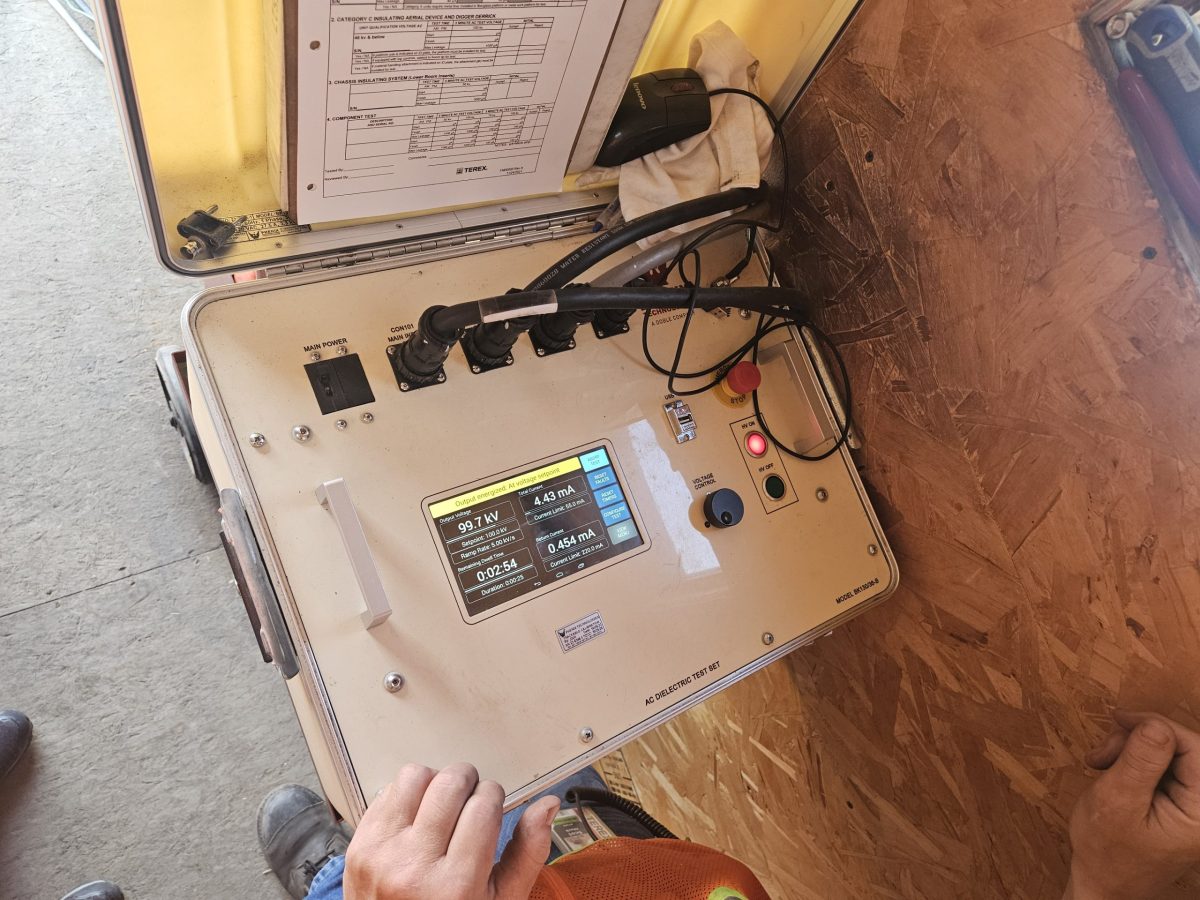
There are two types of dielectric tests that must be performed on insulating aerial devices and digger derricks: qualification tests and periodic tests. A qualification test is required to determine the voltage rating of the unit. A periodic test is conducted at intervals to verify that the equipment continues to provide the expected insulation. Knowing who is responsible for these tests and when to perform them is essential to identifying any defects or weaknesses in the insulating capabilities of the equipment. Once the equipment is in use, the responsibility falls on the owners and users.
New insulating bucket trucks or digger derricks are first tested by the OEM according to ANSI A92.2 5.3.2 or A10.31 5.3.2 requirements, respectively. This qualification test at the factory establishes the insulation rating for the equipment. The installer will then perform a dielectric test to confirm the insulation after a unit is finished and operational. A qualification test is also required if the fiberglass boom is replaced. The original qualification test is then no longer valid.
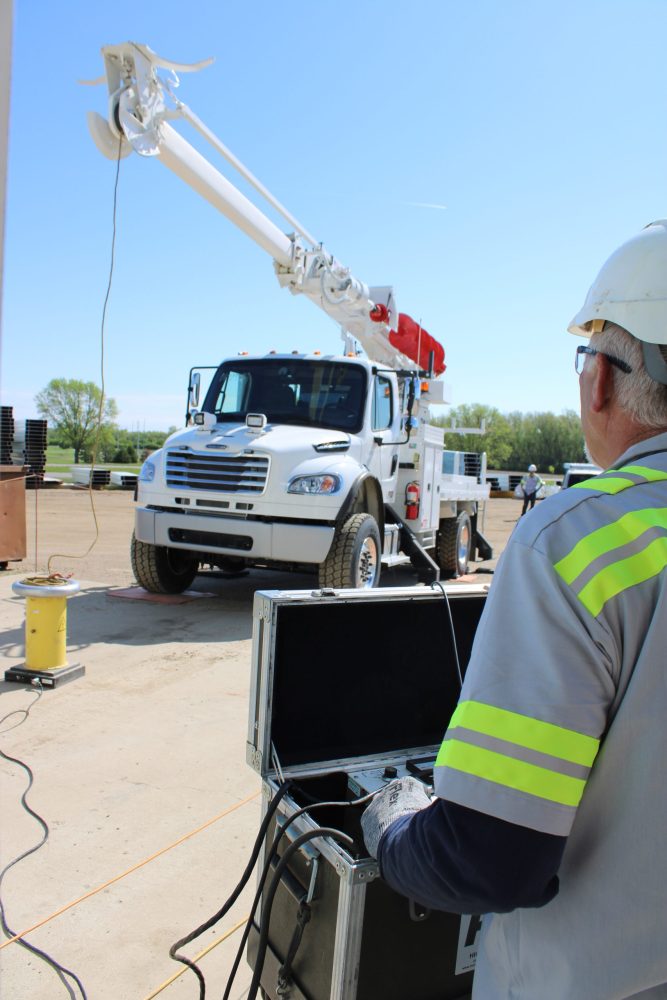
Once insulating equipment is placed in service, maintenance tests – also called periodic tests or annual tests – are required to be performed for a variety of reasons. A maintenance test is required annually for most classifications of machines, or more frequently according to the user’s policy. Maintenance tests are also required after repair or replacement of components in the insulating sections, such as hoses or leveling components. If a problem is suspected, or after unintended contact with energized power lines occurs, a maintenance test will verify the insulation is providing the expected protection and not damaged.
All dielectric testing must be done by a qualified person in accordance with ANSI A92.2 or A10.31 standards. A qualified person is defined as someone who, by possession of an appropriate technical degree, certificate, professional standing or skill, and who, by knowledge, training and experience, has demonstrated the ability to deal with problems relating to the subject matter, the work or project.
If no periodic tests have occurred within a 12-month period, the equipment can no longer be considered insulating. Note that Category A units have different requirements if used for barehand work at least every three months.
Always follow test procedures from ANSI A92.2, A10.31 and the manufacturer to establish consistent methods for measuring the leakage current at specified voltages. Manufacturers will be able to provide the information, and it is included in the ANSI standards. The ANSI A92.2 Manual of Responsibility also provides the aerial test criteria.
Know Your Voltage Ratings
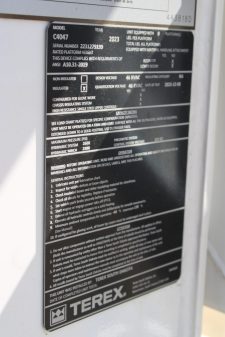
Before conducting any type of dielectric testing, you should first know the machine’s voltage rating and category. Refer to the voltage ratings for the equipment. The ID plate on your bucket truck or derrick will indicate if the unit is insulating and, if so, the voltage and category the insulation is designed and tested to withstand. The equipment manual explains which areas of the machine will provide insulation.
Look on the ID plate for the qualification voltage as well. The number in this area is the voltage rating the unit was tested and qualified for per ANSI standards. The date of the qualification test is indicated on the ID plate as the test date.
There may be two voltages stamped on the ID plate near the lower controls. The qualification voltage is the most important. The design voltage (i.e., the maximum voltage for which the machine can be rated if it is properly equipped and tested) may or may not be shown on the ID plate. The machine cannot be used on lines at the design voltage unless the qualification voltage indicates the same voltage on the ID plate.
Qualification voltage is the maximum voltage for which the upper boom on an aerial device has been tested and is rated. The same is true for digger derricks, which can be used as aerial lifts when equipped with a platform and upper controls to work on electrical system lines. For digger derricks, the fiberglass boom must be fully extended and the load line removed across the insulating section to provide this insulation. If used with a platform, the operation must be controlled by the person on the platform. A digger derrick cannot be used with a platform attached unless the ID plate indicates a platform capacity.
Insulating equipment can be used to work near electrical system lines up to the phase-to-phase voltage if the proper PPE and procedures are used. The insulation provided by the boom is secondary to PPE. Only Category A units, when used following barehand work procedures, will provide primary protection. The ratings are given as the phase-to-phase voltage of the system. The booms are tested based on the phase-to-ground voltage, not the voltage between the phase lines. A 46-kV-rated unit cannot be used on a 69-kV system even though the phase-to-ground voltage of the 69-kV system is less than 46 kV.
Types of Testing
Qualification testing can only be done with an AC testing machine. The test is conducted by qualified service personnel anytime the fiberglass boom section is modified or replaced. A written record of all dielectric tests should be maintained, including both the date and the signature of the person who performed the test.
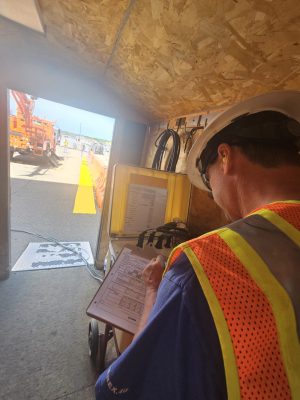
After the aerial device or digger derrick is installed on the chassis, one of two dielectric tests is required to be performed by the installer. They can conduct another qualification test with AC equipment or, if the installer accepts the qualification test from the manufacturer, they can perform a periodic test using AC or DC test equipment. In the case of boom replacement, the OEM tests the boom prior to shipment, but this is not considered a qualification test because the unit must be fully assembled and operational with all components installed in the insulating section. The entity reassembling the unit must perform a qualification test before the unit can be returned to service.
Insulating units should be visually inspected daily. This is especially important when testing in the spring, when birds are nesting. If a unit sits for an hour, a bird may try to build a nest inside. If a dielectric test is performed without inspecting the interior, a fire could result.
A periodic test is necessary whenever there is a question about the equipment’s dielectric properties, such as contaminated or deteriorated fiberglass. This type of test must also be done anytime repairs have been made to components that cross the insulating section. An example is when boom hoses or leveling rods are replaced. A periodic test can be performed with either an AC or a DC testing machine.
Boom positions should be recorded when performing dielectric tests as positioning can cause readings to vary, especially with AC tests. Testing the boom in the same position each time will provide more consistent readings. By comparing the test results year over year, any upward trend in leakage current may aid in determining if the fiberglass boom’s insulating properties are deteriorating, as well as whether the fiberglass, hoses or leveling rods need to be inspected or repaired.
Finally, as previously stated, an annual test must be performed once every 12 months. AC or DC testing equipment can be used. Either a qualification test or a periodic test will suffice for meeting the annual test requirement.
Other Items to Test
In addition to the insulating upper boom sections of bucket and derrick trucks, there are a few other considerations.
Insulating liners, if used, require an annual dielectric test. The liner does not have a rating, only a requirement to be tested. The liner depends on the material’s thickness for its insulating properties. Damage to the liner that reduces its thickness – such as gouges and cuts – can reduce the insulating properties and cause test failure.
It’s a good idea to examine the hydraulic oil and perform a dielectric test on that oil at the same time the booms are tested, especially if the oil is discolored or milky looking. The dielectric strength of the new oil should exceed 25 kV, and used oil should remain above 15 kV when tested per ASTM D877.
High-resistance control handles on aerial devices must be qualification tested using AC equipment. Maintenance tests can be performed using AC or DC equipment. Testing must be performed annually or whenever maintenance is completed that may affect the dielectric integrity of the controls.
The aerial chassis insulating system or lower boom insert, if equipped, may provide some level of protection for personnel on the ground if contact is made below the upper boom insulating section. The insert does not have a rating, only a test requirement. The same test procedures apply as with the upper boom. For the qualification test, only AC equipment can be used; the periodic test can be performed with AC or DC equipment.
About the Authors: Jim Olson and Craig Ries are product safety engineers for Terex Utilities (www.terex.com/utilities).

